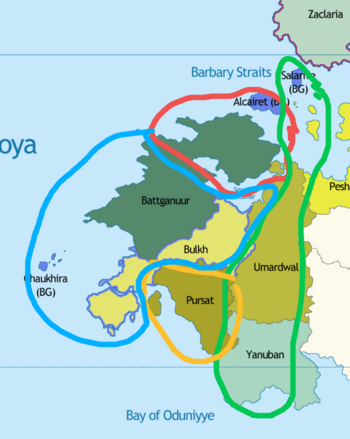Kandahari-Pukhtun colony
| This article is a stub. You can help IxWiki by expanding it. |
Kandahari-Pukhtun Colony Colonie Kandahari-Pukhtun | |||||||
|---|---|---|---|---|---|---|---|
| 1615-1831 | |||||||
|
Flag | |||||||
 Kandahari-Pukhtun colony in green Istroya Oriental colony in blue Eloillette in gold Barbary Straits colony in red | |||||||
| Status | Colony of the Duchy of Bourgondi | ||||||
| Official language | Burgoignesc | ||||||
| Religion | Calvinism/Congregational church, Presbyterianism | ||||||
| Government | Constitutional monarchy | ||||||
| Governor Epistates | |||||||
| Historical era | Age of Discovery, Age of Sail | ||||||
• Established | 1615 | ||||||
• Disestablished | 1831 | ||||||
| |||||||
| Today part of | |||||||
Kandahari-Pukhtun Colony was a colonial holding administered by the Bourgondii Royal Trading Company in central Daria, Audonia from 1615 until the 1830s at which point the Great Rebellion of Slavery Bay overwhelmed the colony forcing its end and the expulsion of the Occidentals living within it.
Mechanisms of expansion

The remnants of the power structures, industrial infrastructure, and academic institutions left by the Oduniyyad Caliphate proved to be crucial assets for the Bergendii colonists as they pursued their expansionist ambitions in the Kandahari-Pukhtun Colony. The infrastructure and knowledge inherited from the Caliphate's rule provided the colonists with a foundation upon which to build their own administrative, economic, and educational systems, thus accelerating the pace of their colonization efforts.
The existing power structures, though weakened after the collapse of the Caliphate in 1517, still held sway over various regions within the colony. The Bergendii colonists skillfully exploited the fragments of these power structures, forging alliances with local leaders and elites who still retained influence and authority. By co-opting these remnants, the colonists were able to establish a semblance of continuity in governance, thereby facilitating a smoother transition to their own administrative apparatus.
The industrial infrastructure of the once powerful Caliphate provided the Bergendii colonists with a financial technological advantage, allowing them to streamline their own production processes and enhance their economic capabilities. They repurposed existing manufacturing facilities and improved upon the technological advancements pioneered by the Caliphate, thereby bolstering their own trade networks and economic dominance in the region.
The academic institutions established by the Oduniyyad Caliphate had fostered a rich tradition of scholarship, scientific inquiry, and cultural exchange. Recognizing the value of this intellectual legacy, the Bergendii colonists harnessed the knowledge preserved within these institutions to further their own educational and intellectual pursuits. They absorbed and built upon the existing scholarly works and academic achievements, integrating them into their own educational systems and research endeavors, thereby nurturing a culture of learning and improvement that made their colony prosperous, efficient, and stable.
Economy
Manufacturing
The manufacturing sector of the Kandahari-Pukhtun Colony thrived not only due to the long standing, state sponsored tradition of manufacture in the Oduniyyad Caliphate, but also due to its pivotal location along the Silk Road, which afforded it an influx of diverse goods and materials from various regions of Eastern Audonia and the Occidental World. This convergence of resources and generational expertise catalyzed a dynamic manufacturing ecosystem that combined indigenous craftsmanship with innovative techniques acquired from foreign sources.
The influx of goods and materials from all over the world provided the colony's manufacturing sector with a diverse range of raw materials, including textiles, metals, spices, and luxury goods. These materials served as the building blocks for the production of an array of high-quality products, including intricately woven textiles, finely crafted metalwork, exquisite ceramics, and luxury items that catered to both local and international markets.
The manufacturing process within the colony was characterized by a fusion of traditional artisanal techniques and the adoption of cutting-edge technologies and methodologies brought in through the Silk Road trade network. Local craftsmen and artisans collaborated with foreign experts, incorporating new manufacturing practices, machinery, and design elements into their production methods, thereby enhancing the quality and diversity of their output.
The exchange of ideas and techniques fostered a culture of innovation and cross-cultural collaboration, leading to the development of unique manufacturing specialties that reflected the diverse influences of the various regions along the Silk Road. This collaborative approach not only bolstered the colony's manufacturing sector but also fostered a vibrant cultural exchange that enriched the artistic and aesthetic landscape of the colony's products.
Furthermore, the thriving manufacturing sector of the Kandahari-Pukhtun Colony played a pivotal role in sustaining the region's economic growth, as the high-quality goods produced within the colony garnered significant demand both domestically and internationally. The colony's strategic position along the Silk Road facilitated the efficient distribution of its manufactured products to markets across Asia and Europe, further solidifying its status as a prominent hub for trade and commerce.
See also
